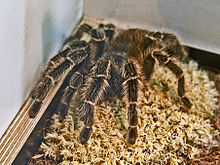| Lasiodora | |
|---|---|

| |
| Lasiodora difficilis | |
|
Scientific classification
| |
| Domain: | Eukaryota |
| Kingdom: | Animalia |
| Phylum: | Arthropoda |
| Subphylum: | Chelicerata |
| Class: | Arachnida |
| Order: | Araneae |
| Infraorder: | Mygalomorphae |
| Family: | Theraphosidae |
| Genus: |
Lasiodora C. L. Koch, 1850 [1] |
| Type species | |
|
L. klugi (C. L. Koch, 1841)
| |
| Species | |
|
7, see text | |
Lasiodora is a genus of tarantulas that was first described by Ludwig Carl Christian Koch in 1850. [2] They are often very large; body lengths of up to 25 centimetres (9.8 in), including the legs, are not unusual.
Diagnosis
This genus can be distinguished from other tarantulas by the presence of hairs used for stridulation on the upper area of the coxae of leg 1 and 2. Males also own a triangular keel below the apex of the palpal bulb, females also have a sclerotized (hardened by sclerotin) area between the two sections of the spermathecae. [3]
Species
As of December 2023 [update] it contains seven species, found in Brazil: [1]
- Lasiodora benedeni Bertkau, 1880 – Brazil
- Lasiodora camurujipe Bertani, 2023 – Brazil
- Lasiodora franciscana Bertani, 2023 – Brazil
- Lasiodora klugi (C. L. Koch, 1841) ( type) – Brazil
- Lasiodora parahybana Mello-Leitão, 1917 – Brazil
- Lasiodora sertaneja Bertani, 2023 – Brazil
- Lasiodora subcanens Mello-Leitão, 1921 – Brazil
Transferred to other genera
- Lasiodora auronitens (Keyserling, 1891) → Pycnothele auripila
- Lasiodora boliviana (Simon, 1892) → Acanthoscurria insubtilis
- Lasiodora brevibulbus (Valerio, 1980) → Crypsidromus brevibulbus
- Lasiodora breyeri (Becker, 1878) → Metriopelma breyeri
- Lasiodora carinata (Valerio, 1980) → Crypsidromus carinatus
- Lasiodora colorata (Valerio, 1982) → Hapalopus coloratus
- Lasiodora drymusetes (Valerio, 1982) → Davus fasciatus
- Lasiodora familiaris (Simon, 1889) → Cyclosternum familiare
- Lasiodora gutzkei (Reichling, 1997) → Acentropelma gutzkei
- Lasiodora icecu (Valerio, 1980) → Crypsidromus icecu
- Lasiodora isabellina (Ausserer, 1871) → Crypsidromus isabellinus
- Lasiodora lakoi Mello-Leitão, 1943 → Megaphobema lakoi
- Lasiodora panamana Petrunkevitch, 1925 → Neischnocolus panamanus
- Lasiodora parvior Chamberlin & Ivie, 1936 → Neischnocolus panamanus
- Lasiodora porteri Mello-Leitão, 1936 → Grammostola rosea
- Lasiodora tetricus (Simon, 1889) → Miaschistopus tetricus
- Lasiodora trinitatis (Pocock, 1903) → Spinosatibiapalpus trinitatis
- Lasiodora trinitatis pauciaculeis (Strand, 1916) → Spinosatibiapalpus trinitatis pauciaculeis
- Lasiodora velox (Pocock, 1903) → Cymbiapophysa velox
- Lasiodora weijenberghi Thorell, 1894 → Eupalaestrus weijenberghi
- Lasiodora zebrata (Banks, 1909) → Davus ruficeps
See also
References
- ^ a b Gloor, Daniel; Nentwig, Wolfgang; Blick, Theo; Kropf, Christian (2023). "Gen. Lasiodora C. L. Koch, 1850". World Spider Catalog Version 24.5. Natural History Museum Bern. doi: 10.24436/2. Retrieved 30 December 2023.
- ^ Koch, C. L. (1850). Übersicht des Arachnidensystems. pp. 1–77. doi: 10.5962/bhl.title.39561.
- ^ Campolina, Carolina; Chatzaki, Maria; Bruna, Bárbara; Carmo, Anderson; de Faria, Flávia; Kalapothakisa, Evanguedes (2015). "The Venom from Lasiodora sp.: A Mygalomorph Brazilian Spider". ResearchGate. Retrieved July 19, 2022.